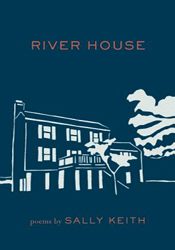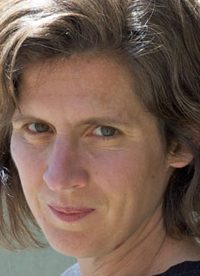
The back cover of Sally Keith’s River House tells us upfront that this is a book which reckons with the writer’s grief after the death of her mother. In this same spirit of disclosure, I want to note that Keith was one my MFA teachers seven years ago when I was writing a thesis that largely dealt with the death of my mother. Does this affect my ability to read and respond to Keith’s work? I’d argue it does not, but it is part of what I bring to the page as a reader. My connections to River House’s subject matter, more so than my connections to the poet herself, definitely shaped what I found myself focusing on as I read.
River House contains sixty-three single paged and numbered, but otherwise untitled, poems. Before you reach the poems there is a page with two lines: Ann Elmore Keith / (1947-2010). Do the math and that is sixty-three years. The poems do not linearly chronicle those sixty-three years, but the choice of sixty-three poems feels considered. Considered is a good way to describe this collection in general. As I went back over my notes and tried to decide which poems to discuss I found it difficult to pick out individual passages because the poems are so tightly woven and relevant to each other.
The first poem in River House describes the red sky, “the boats in the small harbor, docked,” and the “house [that] sits high up on stilts.” I can see this house. I mentally compare it to the house on stilts where I lived as a child, but even without that connection I think other readers will sense the tangibility of the house. This very real sense of structure and place is then contrasted with an idea. The very first line of the poem asks: How do you picture the shape of a year in your head.
The poem will circle back to this question as it notes, “a year is a circle,” but it also complicates that circle by saying, “it all depends on where you start.” We are a very straight-lined culture: always looking forward and back so this desire to take a different shape as a way to examine life is compelling.
The notion of circles, circularity, is repeated in this collection. There are other repeated ideas and images, but I am often drawn to examining the literal and metaphoric shape of things, especially the circle. A circle makes me think of the moon and then water in its constant cycle. These circular things that connote a touch of the feminine and at the center of them all is the hearth – the house.
The house versus the river. The house as this static thing versus the constantly moving river. There are many instances where the river and house work for and against each other, but perhaps my favorite is in the thirteenth poem where the speaker and her father sit and watch from the deck of the river house, “an eagle / fly at another, grab it by its talons. The two turn wild circles / . . . and fly off just before hitting the water.”
This natural, primal scene is circular yet also feels somewhat incomplete, and that is also how grief progresses. Grief is not a line. Keith also uses the image of a lyre to further explore the mutability of grief. The lyre, Keith writes, in a commedia can take one “plucked note / to move from the depths of despair to the fullness of joy.” Grief isn’t, therefore, the solidity of a foundation. It has more of the fluidity of water.
So in this poem, and others in the collection, there is the safety, the familiarity of the house, and yet the moment with the eagles exemplifies for the speaker and her father that a moment like that (as with all moments) is most likely one instance you never see again. The cliche I would use here is fleeting.
As I try to discuss Keith’s work I find myself hoping I can do it justice. I feel on an edge. Like I almost have a handle on what I want to say, but not quite.
 In this collection Keith often refers to her habit (one which I share) of taking notes while reading. I think that is the best compliment I can give to an author: that they said something I had to circle or underline. And there is one tercet in poem twenty-three that, for me, said it all: To cry in a movie you know your mother would have loved / is not one of the moments you expect / and yet.
In this collection Keith often refers to her habit (one which I share) of taking notes while reading. I think that is the best compliment I can give to an author: that they said something I had to circle or underline. And there is one tercet in poem twenty-three that, for me, said it all: To cry in a movie you know your mother would have loved / is not one of the moments you expect / and yet.
Yes, and yet. That’s what we have to reconcile ourselves with after loss. We will have yet, and all the connotations that come with moving on while looking back.




